Lagvinari
by
Kathy Sullivan
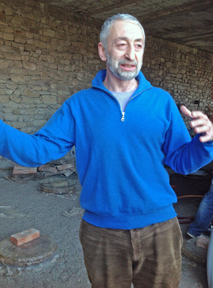 Summary: Dr. Irakli Glonti of Lagvinari is a fascinating individual to talk with about Georgia and wine. We enjoyed visiting his marani followed by a comprehensive conversation and wine tasting outside of the marani. Visitors to Georgia will quickly realize how welcoming Georgians are to strangers. Dr. Glonti exemplified this by inviting us to his home in Tbilisi that night. Many thanks to Dr. Glonti for sharing his time, food, wines and life story with us.
Summary: Dr. Irakli Glonti of Lagvinari is a fascinating individual to talk with about Georgia and wine. We enjoyed visiting his marani followed by a comprehensive conversation and wine tasting outside of the marani. Visitors to Georgia will quickly realize how welcoming Georgians are to strangers. Dr. Glonti exemplified this by inviting us to his home in Tbilisi that night. Many thanks to Dr. Glonti for sharing his time, food, wines and life story with us.
We met Dr. Irakli Glonti, owner and winemaker, who preferred being called Eko. He warmly welcomed us to his marani where he has several qvevris, noting that qvevri is “a place of birth and burial. Fermenting is the process of decomposing.”
Eko has had an interesting wine journey beginning with an interest in consuming wine. He has always enjoyed wine. He tasted wine since childhood when he was three years old. He remembers when, at age five, he was allowed to drink wine mixed with water. By the time he was 16, he could drink several bottles of wine.
Eventually Eko viewed a video about qvevri winemaking and decided to begin producing his own wine.
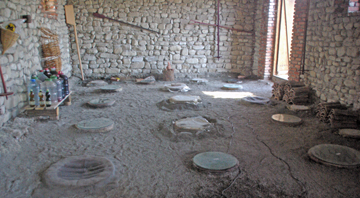 After a career as a doctor, Eko began making organic wines in 2011. Currently at his marani he has five hectares of grapes on the slopes. At another vineyard he has five hectares of grapes also located on slopes. Eko is experimenting with different grape varieties to plant in the Kakheti region of Georgia. Eko also works very closely with organic small vine growers in Western Georgia.
After a career as a doctor, Eko began making organic wines in 2011. Currently at his marani he has five hectares of grapes on the slopes. At another vineyard he has five hectares of grapes also located on slopes. Eko is experimenting with different grape varieties to plant in the Kakheti region of Georgia. Eko also works very closely with organic small vine growers in Western Georgia.
The Marani
The qvevris were covered with glass tops. Between the glass and the lip of the qvevri there is a layer of clay. Eko took a putty knife and gently pressed it between the clay and the glass. This helped break the seal and the glass covering could be removed. Before replacing the glass, a sulfur strip is burned. The sulfur gas is heavier than air and sinks to the surface of the wine in the qvevri replacing the air. The glass can then be pressed into the clay to form a seal. Oxygen is kept away from the wine.
Outside of the marani, we sat at a picnic table to taste some of Eko’s wines. The white wines were taken from the qvevris.
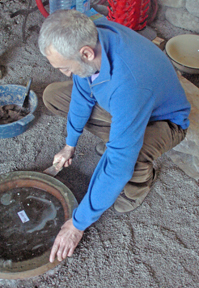

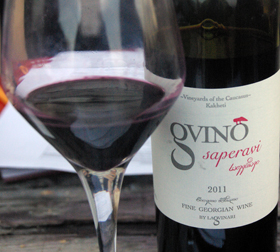 Wines
Wines
The Tsolikouri 2013 was a gold color with a floral aroma. The taste offered nectarine and floral notes. The finish was crisp with bold tannins. One hundred percent of the chacha (pomace) including the skins and seeds was added to the juice. Chinuri 2013 was a gold color with floral notes. The finish was crisp with tannins. Krakhuna was a yellow color with floral notes. The finish offered bold tannins making one’s lips pucker, reminding one of a kissing wine. Goruli Mtsvane was a gold color with a light gold rim. Eko produced this wine by leaving it on the chacha for 45 days. The wine offered tropical fruit with floral notes. The tannins were intense again reminding one of a kissing wine. Tsitska, a gold colored wine, offered an aroma of floral notes. The taste also had floral notes including honeysuckle and daisies. The wine had bold, kissing wine tannins.
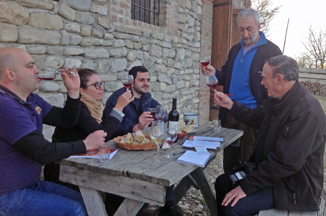 Chaveiri was produced by spending 30 days on chacha (pomace.) The result was a wine with a ruby color and a rose tint. The aroma and taste offered dark fruit notes with tannins. Otskhanuri Sapere had dark fruit notes. The wine had tannins with a crisp finish followed by spice and fruit. Saperavi was a dark purple to black color. The aroma was of spice and dark fruits. The taste reminded one of blackberries and plums. This wine also had kissing tannins. The finish was fruity.
Chaveiri was produced by spending 30 days on chacha (pomace.) The result was a wine with a ruby color and a rose tint. The aroma and taste offered dark fruit notes with tannins. Otskhanuri Sapere had dark fruit notes. The wine had tannins with a crisp finish followed by spice and fruit. Saperavi was a dark purple to black color. The aroma was of spice and dark fruits. The taste reminded one of blackberries and plums. This wine also had kissing tannins. The finish was fruity.
Chacha
Chacha is the name for a distillation of the pomace that is also called chacha. The Lagvinari Chacha we tasted was produced with the grape variety Rkatsiteli. This Chacha had alcohol on the aroma and the finish. The Chacha had a lovely color and the alcohol level was significant. The color was achieved by adding a fruit or flower to the Chacha.
In addition to selling his wines in Georgia, Eko exports his wines to the United Kingdom, Austria, France and Latvia.
Article Written April 2014
